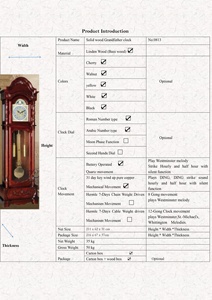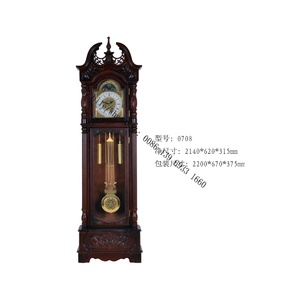
All categories
Featured selections
Trade Assurance
Buyer Central
Help Center
Get the app
Become a supplier

(1568 products available)



















































The clock mechanism pendulum is a timekeeping device that uses a swinging pendulum to regulate the clock's movement. Its periodic swing back and forth provides the timekeeping element. There are several different types of clock mechanism pendulums, each with unique features and advantages.
Longcase clock movement pendulum
The longcase clock movement pendulum, commonly known as the grandfather clock pendulum, is one of the most recognizable types. It consists of a heavy bob attached to a thin rod, which swings back and forth to keep time. The longer the pendulum, the more accurate it is since it has a lower frequency. Longcase clocks usually employ a verge escapement or a more accurate cylinder escapement to regulate their timekeeping.
Grandfather clock pendulum mechanism
Grandfather clocks are essentially longcase clocks that originated from America; thus, their mechanisms are similar. They use large and often decorative pendulums for timekeeping, just like in long cases. These clocks typically feature complex gearing systems and high-quality materials to ensure precision over decades.
Mechanical clock pendulum
Mechanical clock pendulums can be found in various sizes, from small mantel clocks to large public clocks. They are usually made of metal, wood, or a combination of both. Mechanical clock pendulums rely on the principle of swinging mass to maintain a regular oscillation, which in turn regulates the timing of the clock. The main components of a mechanical clock pendulum include the rod, bob, suspension system, and escapement. The rod connects the bob to the pivot point where it swings back and forth. The heavier the bob is, the more slowly it will swing; hence larger bobs are used for slower timekeeping mechanisms.
Quartz clock pendulum
Quartz clock pendulums are another popular option due to their accuracy and low maintenance requirements. They use quartz crystals to regulate timekeeping, making them much more precise than mechanical clocks. In quartz clocks, the pendulum serves as an aesthetic element rather than a functional one since the actual timing is done by electronic circuits.
Electronic clock pendulum
With advancements in technology, electronic clock pendulums have emerged as another type of mechanism. These devices use sensors and microcontrollers to replace traditional mechanical parts, making them more efficient and compact. Electronic clocks with pendulums can be programmed for various functions, such as setting alarms or keeping track of different time zones.
Various designs of clock mechanism pendulums are available for different types of clocks. Each design has unique properties, advantages, and aesthetic appeals. They can be classified based on their appearance, purpose, and construction.
Based on appearance
There are two main types of clock pendulum mechanisms based on their looks. An exposed clock pendulum has all its parts visible for easy observation. It is often seen in wall clocks or grandfather clocks. A concealed clock pendulum hides its components inside a case or structure. It makes the clock look neater and protects the parts from damage or dirt.
Based on purpose
Timekeeping pendulums help keep accurate time in clocks. Decorative pendulums may not be very accurate, but they are designed to look beautiful. Stabilizing pendulums keep the clock's movement steady and balanced.
Based on construction
Some clock pendulums are made of metal, wood, or plastic. A metal pendulum is strong and long-lasting. A wooden one looks nice and is traditional. Plastic pendulums are affordable and suitable for modern uses. Clock pendulums also have different shapes. Round pendulums look smooth and simple. Long pendulums are good for accuracy. Flat pendulums can be used in slim or space-saving designs.
Based on mechanism
There are gear clock pendulum mechanisms, quartz clock mechanisms, and weight-driven clock mechanisms. The gear clock mechanism uses gears to transfer energy from the pendulum to the clock hands to make them move. It usually has a pendulum that swings back and forth to keep time. It is commonly found in wall clocks and tabletop clocks. A quartz clock mechanism uses a battery-powered quartz crystal to keep time very precisely. The pendulum in a quartz clock is mainly for show and does not affect the timekeeping. A weight-driven clock mechanism uses weights, strings, and pulleys to move the clock. The pendulum regulates the time in these clocks, which are often bigger and more complicated.
Education:
In classrooms, pendulum wall clocks can be used to teach students about time and the science of pendulums. Students can learn about clock parts, including how a clock mechanism pendulum works. They can also conduct simple experiments to learn about factors affecting pendulum motion, such as length and mass. Observing a pendulum clock reinforces lessons on timekeeping, energy transfer, and oscillation. Clocks with pendulum mechanisms are effective teaching aids for subjects like physics, math, and history.
Aesthetics:
In a world where technology dominates, pendulum clocks bring a unique aesthetic appeal. Their swinging motion adds a dynamic element to room decor. The rhythmic movement of the pendulum can have a calming effect, enhancing the ambiance of the space. Pendulum clocks are not just functional; they also contribute to the visual and psychological aspects of interior design, making them a valuable addition to any room.
Artistic installations:
Art installations sometimes use pendulum clocks. Artists integrate the clocks into their work to represent time, motion, or change. The clocks can be synced or unsynced with each other to create visual or kinetic effects.
Historical exhibits:
Exhibits in history museums often use pendulum clocks to showcase timekeeping in the past. Visitors can learn about the history of clockmaking and advancements in timekeeping technologies.
Architectural design:
Buildings and public spaces sometimes incorporate pendulum clocks as architectural features. These clocks can be focal points or contribute to the building's character. For example, a large pendulum clock may hang in an atrium, emphasizing the space's height and openness.
Wayfinding:
In complex buildings, pendulum clocks can assist with navigation. Their distinct appearance and rhythmic motion make them suitable landmarks. People can use the clocks to orient themselves and estimate the time as they move through the space.
When selecting a clock mechanism, several important factors should be considered to ensure that the right choice is made. These factors will help users choose a clock mechanism that suits their needs and fits well with the design requirements of the timepiece being constructed.
Purpose and requirements:
It is essential to determine what one needs from a clock mechanism. Consider the specific requirements and features desired, such as timekeeping accuracy, power source, type of display (analog or digital), additional functions like alarms or timers, and any special requirements for the design or functionality of the clock.
Type of mechanism:
Various mechanisms are available for different types of clocks, each with its advantages. Quartz movements are popular for their accuracy and low maintenance, especially for wall clocks. Mechanical movements offer traditional craftsmanship and require winding. Pendulum mechanisms are fascinating for their historical significance and stability, particularly in large clocks.
Power source:
Consider what will power the clock mechanism. Quartz movements usually require batteries, while mechanical movements need winding by hand. The choice of power source should be compatible with the design and environment of the clock.
Size and weight:
The size and weight of the clock mechanism should be compatible with the design of the clock. Quartz movements are compact, while mechanical movements can be bulkier. Ensure that the chosen mechanism fits well within the clock body without adding excessive weight, which could affect the clock's appearance or stability.
Mounting and installation:
Examine how easy it is to install the clock mechanism. Check what mounting points and installation instructions are provided. Ensure that the mechanism can be easily mounted in the desired position and that any required tools or parts for installation are readily available.
Quality and durability:
Opt for clock mechanisms made by reputable manufacturers known for their quality and durability. A reliable mechanism will provide accurate timekeeping, require minimal maintenance, and have a longer lifespan. Avoid cheap or generic mechanisms that may compromise performance and reliability.
Cost:
Budgeting is essential when choosing a clock mechanism. Compare prices across different suppliers, but prioritize quality and features over cost. Ensure that the clock mechanism fits within the overall budget for the clock project.
Customization options:
Some clock mechanisms allow for customizations, like changing the length of the pendulum or the style of the clock hands. Customization ensures that the clock mechanism matches the design and aesthetic requirements of the clock being built.
Q1: What is the difference between a clock mechanism and a clock movement?
A1: The terms clock movement and mechanism refer to the same thing. Both terms describe the internal machinery of a clock that governs its timing and movement. They can be used interchangeably. The clock mechanism or movement consists of gears, wheels, and other parts that work together to keep time and move the hands.
Q2: How do temperature changes affect a pendulum clock mechanism?
A2: Temperature fluctuations can change the length of the pendulum rod and the viscosity of the lubricants within the clock. This alters the period of the pendulum, thus affecting the timekeeping of the clock. Lubricants may become thinner or thicker due to temperature changes, impacting friction and clock speed.
Q3: What materials are commonly used in clock mechanisms and pendulums?
A3: Modern clock mechanisms often utilize materials like plastic, brass, and quartz for their efficiency and cost-effectiveness. Traditional pendulum clocks usually incorporate metals such as brass or wood for the clock pendulum, ensuring durability and enhancing aesthetic appeal.
Q4: Can any clock face be paired with a different mechanism?
A4: Different clock faces and mechanisms can be matched as long as the sizes and connection points correspond. This allows for customizing clocks, giving them a unique look while using different mechanisms. However, the compatibility and power requirements must be considered to ensure proper functionality.
Q5: How does the gear train in a clock mechanism work?
A5: The gear train in a clock mechanism transfers energy from the power source (like a spring or weight) to drive timekeeping elements. It consists of interlocking wheels that reduce the large wheel's fast rotation into slower, controlled movements for the time display hands.